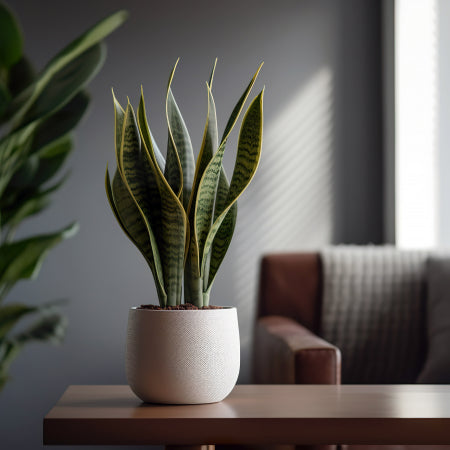How Indoor Plants First Came To Be: A Brief History
Indoor houseplants have been a common and frequently used kind of home décor for as long as I can remember. They are the ideal connection point between the natural, green outdoors and the concrete, metropolitan inside. They assist us build a more harmonious environment for more comfortable living by bridging the gap between the two worlds. It never hurts to have a little greenery indoors, right? It has been demonstrated to offer a plethora of unmatched advantages for both the body and the mind.
LET’S GET INTO A LITTLE INTO
- INDOOR PLANTS
These are, as the name implies, indoor plants that are grown for gardening or even for aesthetic purposes. They are frequently planted in containers that enhance the aesthetics of any space and foster an atmosphere that is consistent with the planting person’s personality and character.
The ability of indoor houseplants to readily convey the personality of the person who is taking care of them is one of its many appealing qualities. They are also able to discuss in great detail the type of house it is, its atmosphere, and a host of other topics. For these and many other reasons, houseplants are therefore quite popular, and their popularity graph continues to rise.
HOW DID INDOOR PLANTS GET INTRODUCED
It is thought that the first people to bring plants indoors were the Egyptians. They wanted to develop greener homes to improve the environment and emulate nature in the comfort of their own homes. Approximately 5000 years ago, the Sumerians and ancient Egyptians brought interior plants such as palm palms and ferns to liven up otherwise boring spaces. To do this, they added even more splashes of colour using ornate pots and colourful planters.
Though these societies are credited with being the first to introduce plants indoors, there are rumours that they did so outside, in courtyards and terraces, rather than inside four walls. Potted house plants have a long history dating back to the Greeks and Romans, who are credited with keeping little indoor house plants to spruce up their dwellings.
The disputes rage on, as they always do, but the truth remains that the Egyptian, Roman, and Greek cultures were the first to bring plants indoors and set the precedent for modern living.
TYPES AND TRENDS OF INDOOR PLANTS AT THE TIME
The treatment and usage of indoor houseplants were very different from what it is today when they first started to become popular. Similar to now, there were many different trends that changed all the time. But other traditions from that era have endured and grown in significance within their communities.
These situations can be found in societies such as those in China, Vietnam, Japan, and China. Using deliberate dwarfing, these communities produced the best indoor plants for residential use. Plants were often dwarfed in these countries to make them compact and manageable, and these techniques gave rise to popular customs.
You might be surprised to learn that the term “bonsai” has its origins in Penjing, China, where drastic techniques for dwarfing trees were used.
Terracotta pots were very popular at the time because they were easily maintained, readily accessible, and created in large quantities. As a result, indoor houseplants grew popular and many individuals were able to add bonsai and terracotta pots to their houses.
EVOLUTION OF HOUSEPLANTS
The Victorian era saw a rise in the popularity of indoor plants. Victorians got interested in plants, and after that, botanists began giving advice to people about how to maintain indoor plants, what kinds of indoor plants to keep, how to take care of them, and about other plants that one could start from scratch at home. For good reason, low-maintenance indoor plants were becoming increasingly popular.
The lower class was also abruptly opened up to a wide range of possibilities in the 18th century as London, one of the most sought-after locations in Europe at the time, expanded in terms of population and variety. The idea of having houseplants indoors ceased to be exclusive and became popular throughout Europe, eventually spreading to every corner of the globe.
Houseplants are a common sight these days, and a wide range of interior décor styles have evolved and woven themselves around including plants in their aesthetic. Nowadays, we have smaller versions of larger indoor plants like palm trees and ferns in addition to various tiny houseplants. They have become popular and are a popular choice for both experienced and novice gardeners because of their low maintenance needs and visual appeal.
LOW MAINTENANCE OF INDOOR PLANTS
These six low-maintenance plants are simple and convenient to grow and care for at home. Don’t worry, you won’t kill them even if you’re an amateur.
- The jade plant
- The spider plant
- Another variety of indoor plants that you can keep at home is the snake plant.
- The money plant and its various forms
- Monstera, a plant that grows more eye-catching and unusual
- Fortunate bamboo
There are many different kinds of indoor houseplants to suit your taste, regardless of what you want in plants, pots, and planters. There are many different types of plants waiting to be found by you, ranging in size from little indoor house plants to enormous living room plants.
At Little Jungle, our indoor plants are going to elevate the aesthetics of your space taking them to the next level. If you are looking to buy indoor plants online, our indoor plants have the knack for making your space more Pinteresty and aesthetic appeal!







